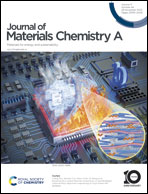Two-dimensional nickel cyano-bridged coordination polymer thermally derived potent electrocatalysts for alkaline hydrogen evolution reaction†
Abstract
Because of its sustainability and cleanliness, hydrogen has recently been a research focus as a potential fuel. One promising way to produce hydrogen is water electrolysis in an alkaline solution. However, this process requires much energy to split the H–OH bond and transfer multiple electrons/protons. To overcome this challenge, catalytic electrodes have been developed to reduce the energy needed and maintain sustainable water electrolysis. This study explores the potential of utilizing a two-dimensional nickel-based cyanide coordination polymer (2D Ni-CP) precursor to synthesize effective Ni-based inorganic nanostructured electrodes. Various types of electrodes, including Ni-O, Ni-S, Ni-Se, and Ni-P, are synthesized through direct thermal treatment of the coordination polymer. The performance of the as-prepared materials in the hydrogen evolution process (HER) in an alkaline medium is examined. Ni-P demonstrates the most promising HER performance with an overpotential of 266 mV at 10 mA cm−2 and a Tafel slope of 186 mV dec−1. These results are compared to those of the benchmark expensive and scarce Pt/C-40% catalyst (38 mV and 48 mV dec−1) examined under identical conditions. Additionally, Ni-P shows outstanding HER durability over four days, as reflected by chronopotentiometry measurements.



 Please wait while we load your content...
Please wait while we load your content...